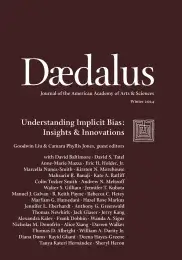Preface: Recognizing Implicit Bias in the Scientific & Legal Communities
Several years ago, in the Fall 2018 volume of Dædalus, we wrote “Bridging the Science-Law Divide,” an essay about the work of the National Academies of Sciences, Engineering, and Medicine’s Committee on Science, Technology, and Law.1 In that essay, we discussed the importance of having the legal and scientific communities engage with each other on a host of issues, and highlighted work that the committee conducted on the courts’ handling of scientific evidence and on society’s governance of emerging technologies. We mentioned that, in the coming years, the committee hoped to focus on the issue of implicit bias (referred to as “unconscious bias” in our 2018 essay), as it was becoming increasingly evident that factors outside individual awareness were affecting personal and institutional decision-making that hindered the full participation of all our citizens.
In a provocative talk at Georgetown University in 2017, Justice Ruth Bader Ginsburg remarked that confronting unconscious bias would be the next big challenge for the courts. The Supreme Court, in an opinion by Justice Anthony M. Kennedy, recognized the importance of addressing disparate impact liability, as it helps uncover discriminatory intent and counteract unconscious prejudices.2
Not only are the courts wrestling with implicit bias but society has begun to recognize that implicit bias is a challenge for society at large, playing out in all kinds of environments: education, policing, housing, and everyday activities. In facing this challenge, we have been thrilled to receive encouragement from colleagues like Darren Walker, president of the Ford Foundation, who agreed to support our effort to focus on the science of implicit bias by providing our committee with the opportunity to organize a workshop on this important topic. The 2021 workshop, entitled “The Science of Implicit Bias: Implications for Law and Policy,” which was thoughtfully cochaired by Justice Goodwin Liu and Dr. Camara Jones, vividly highlighted how implicit bias is hindering our country’s ability to give all citizens opportunities to reach their full potential, and become fully engaged members of our nation.
As we see from the essays in this volume—that focus on what science tells us about implicit bias, what the implications of not addressing it are for a fair and equitable society, and what might be done to lessen its impact—implicit bias does not have to be the determining factor in our decision-making. We can build a society and institutions that take steps to mitigate some of its harmful effects. Thus, we hope you find the essays in this collection informative. We were delighted to read pieces by many of the experts who participated in the 2021 workshop and to learn from others who agreed to contribute to this volume.
